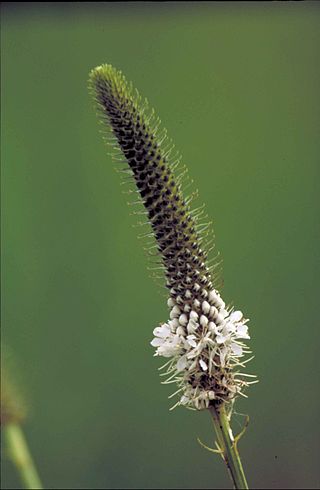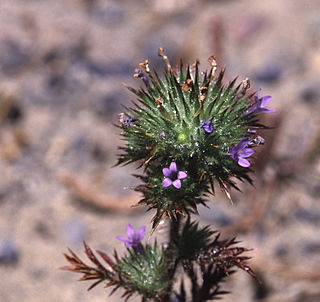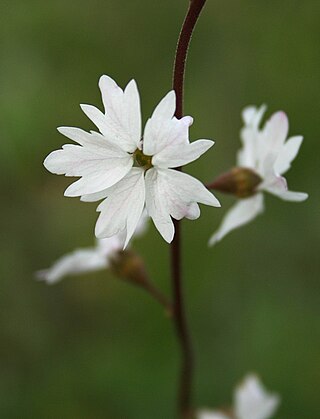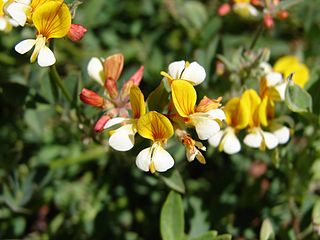
Ceanothus is a genus of about 50–60 species of nitrogen-fixing shrubs and small trees in the buckthorn family (Rhamnaceae). Common names for members of this genus are buckbrush, California lilac, soap bush, or just ceanothus. "Ceanothus" comes from Ancient Greek: κεάνωθος (keanōthos), which was applied by Theophrastus to an Old World plant believed to be Cirsium arvense.

Cercocarpus, commonly known as mountain mahogany, is a small genus of at least nine species of nitrogen-fixing flowering plants in the rose family, Rosaceae. They are native to the western United States and northern Mexico, where they grow in chaparral and semidesert habitats and climates, often at high altitudes. Several are found in the California chaparral and woodlands ecoregion.

Lespedeza is a genus of some 45 species of flowering plants in the pea family (Fabaceae), commonly known as bush clovers or Japanese clovers (hagi). The genus is native to warm temperate to subtropical regions of eastern North America, eastern and southern Asia and Australasia.

Lotus, a latinization of Greek lōtos, is a genus of flowering plants that includes most bird's-foot trefoils and deervetches and contains many dozens of species distributed in the eastern hemisphere, including Africa, Europe, western, southern, and eastern Asia, and Australia and New Guinea. Depending on the taxonomic authority, roughly between 70 and 150 are accepted. Lotus is a genus of legumes and its members are adapted to a wide range of habitats, from coastal environments to high elevations.

Camissonia, sometimes commonly known as sun cup or sundrop, is a genus of annual and perennial plants in the evening primrose family Onagraceae. A total of 12 species are known, nearly all from western North America, especially in the California Floristic Province, but also one from South America. Previous circumscriptions of the genus had recognized up to 62 species before it was split among other closely related genera.

Linanthus is a genus of annual and perennial plants in the phlox family Polemoniaceae. The species are found in western North America and in Chile, with the greatest diversity in California.

Astereae is a tribe of plants in the family Asteraceae that includes annuals, biennials, perennials, subshrubs, shrubs, and trees. They are found primarily in temperate regions of the world. Plants within the tribe are present nearly worldwide divided into over 250 genera and more than 3,100 species, making it the second-largest tribe in the family behind Senecioneae.

Dalea is a genus of flowering plants in the legume family, Fabaceae. Members of the genus are commonly known as prairie clover or indigo bush. Its name honors English apothecary Samuel Dale (1659–1739). They are native to the Western hemisphere, where they are distributed from Canada to Argentina. Nearly half of the known species are endemic to Mexico. Two species of Dalea have been considered for rangeland restoration.

Navarretia is a genus of flowering plants related to the phloxes and the gilias. This is one genus of plants, among others, which are sometimes called pincushion plants. It includes 45 species native to the Americas. In North America they range from western Canada through the western and west-central United States to northwestern Mexico, and to Ohio and Pennsylvania. In South America they range through Argentina and Chile.

Lithophragma is a genus of flowering plants in the saxifrage family containing about nine species native to western North America. These plants are known generally as woodland stars. The petals of the flowers are usually bright white with deep, long lobes or teeth. Each petal may look like three to five petals, when at closer inspection the lobes fuse into a single petal at its base. Most species reproduce via bulblets instead of seeds. L. maximum is a federally listed endangered species. Lithophragma specifically coevolved with moths of the genus Greya, who pollinate and only lay eggs on Lithophragma plants.

Orthocarpus, or owl's-clover, is a genus of flowering plants in the family Orobanchaceae (broomrapes). They are native to North America. A number of species formerly included in Orthocarpus have been transferred to the genus Castilleja, which includes the plants commonly known as Indian paintbrush. Plants of the genus are generally less than 30 centimetres (1 ft) in height.

Madieae is a tribe of flowering plants in the family Asteraceae. It is sometimes considered a subtribe of Heliantheae. Notable species include the tarweeds of the Western United States as well as the silverswords of Hawaii.

Acmispon cytisoides, synonyms Lotus benthamii and Syrmatium cytisoides, is a species of legume native to California. It is known by the common names Bentham's broom and Bentham's deerweed. It is endemic to central California, where it occurs along the Central Coast and into the coastal mountain ranges. It grows in oceanside habitat and inland on slopes and in canyons. It is a mat-forming or spreading perennial herb lined with leaves each made up of a few oval leaflike leaflets up to 12 mm long. The inflorescence bears up to 10 dull pinkish dark-veined flowers, each just under 1 cm long.

Acmispon dendroideus, synonym Syrmatium veatchii, is a species of legume native to California. It is known by the common name island broom. It is endemic to the Channel Islands of California, where it grows on coastal bluffs and cliffs. It is a spreading perennial herb or erect shrub approaching 2 meters in height. It is hairless to hairy and gray-green in color. The branches lined with leaves each made up of a few oval leaflike leaflets up to 1.5 centimeters long each. The inflorescence bears up to 10 yellow pealike flowers, each roughly a centimeter long and fading red as they age.

Acmispon micranthus is a species of legume native to California and northwestern Mexico. It is known by the common name San Diego bird's-foot trefoil. It is found in the coastal mountain ranges of California and Baja California, where it grows in various types of scrub and canyon habitat. It is an annual herb taking a spreading or upright form. It is lined with leaves each made up of oval leaflets each about a centimeter long. The inflorescence is a small bunch of red and yellow flowers. Each flower is in a tubular calyx of sepals and is only a few millimeters long. The fruit is a narrow, bent legume pod up to 1.5 centimeters long, including the hooked beak at the tip.

Hosackia is a genus of flowering plants in the family Fabaceae (legumes). It is native to western North America, from British Columbia in Canada to Mexico.

Syrmatium was a formerly accepted genus of flowering plants in the family Fabaceae (legumes), native to the southwestern United States. As of February 2021, it was considered a synonym of Acmispon by Plants of the World Online, and only Acmispon was recognized by the Jepson eFlora.

Acmispon decumbens is a species of flowering plant in the family Fabaceae, native to the western United States and north-western Mexico. It was first described by George Bentham in 1836 as Hosackia decumbens.

Calyptridium is a genus of flowering plants belonging to the family Montiaceae.
Acmispon tomentosus is a perennial plant in the family Fabaceae in the genus Acmispon. It is native to California and northwestern Mexico. The variety A. tomentosus var. glabriusculus has the synonym Acmispon heermannii.


















